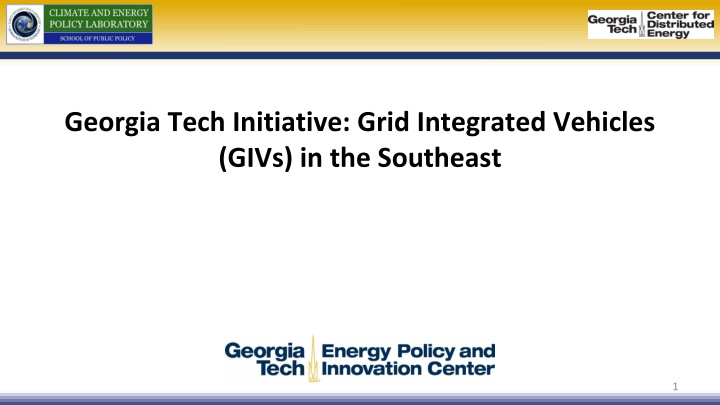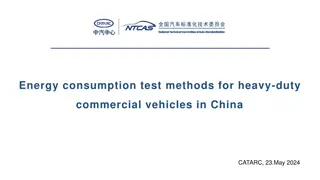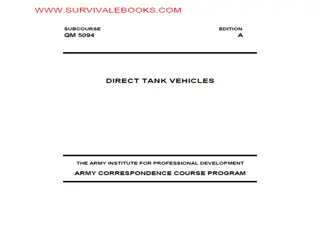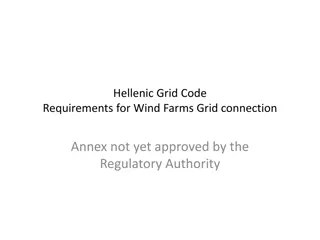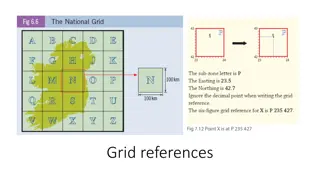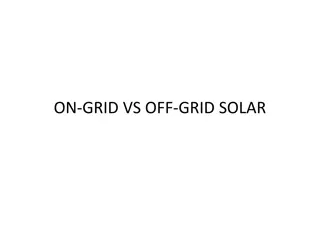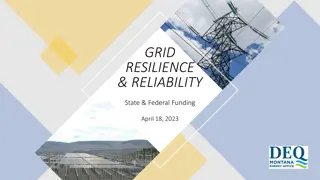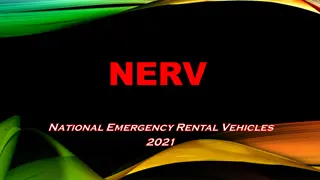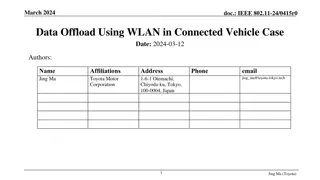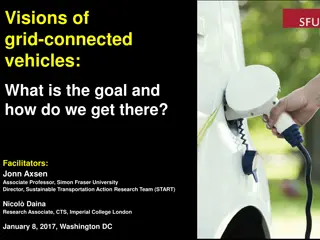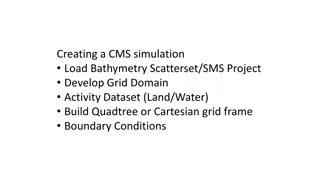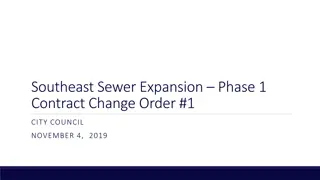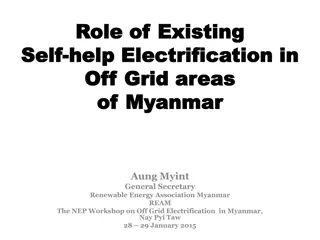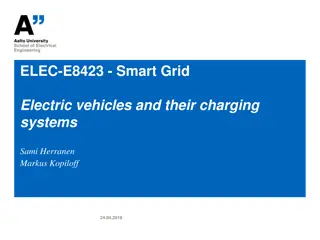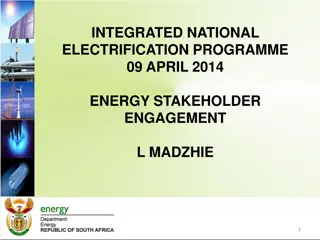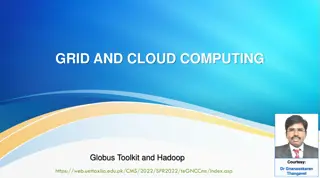Grid Integrated Vehicles in the Southeast
This initiative explores the integration of Grid Integrated Vehicles (GIVs) in the Southeast region, focusing on technical components, business models, utility adaption, economic impacts, and cost-benefit analysis.
Download Presentation

Please find below an Image/Link to download the presentation.
The content on the website is provided AS IS for your information and personal use only. It may not be sold, licensed, or shared on other websites without obtaining consent from the author.If you encounter any issues during the download, it is possible that the publisher has removed the file from their server.
You are allowed to download the files provided on this website for personal or commercial use, subject to the condition that they are used lawfully. All files are the property of their respective owners.
The content on the website is provided AS IS for your information and personal use only. It may not be sold, licensed, or shared on other websites without obtaining consent from the author.
E N D
Presentation Transcript
Georgia Tech Initiative: Grid Integrated Vehicles (GIVs) in the Southeast 1
Outline Introduction GIV Modes and Services Technological Considerations Business Models Utility Models Cost Benefit Analysis NEMS Input Output (IMPLAN) 2
Electric Vehicles Business Models for the Southeast Research Questions What is the status of the technical components needed to support GIVs? What business models can increase the adoption of GIVs in the Southeast? How can GIV be adapted to the vertically integrated utilities in the Southeast? What impacts might GIV have on the economy as well as the energy sector in the Southeast? What are the benefits and costs and are there winners and losers? 4
Modes of Grid Integrated Vehicles Grid to Vehicle (G2V) Vehicle to Buildings (V2B) Vehicle to Grid (V2G) Demand Response Demand Charge Reduction Capacity firming Valley Filling Voltage Control Reserves Negative Demand Response Negative Demand Response Reserves Coordinated Charging Emergency Back-up Frequency Regulation How much are these services worth? What is their marketplace value: today and in the future? 7
TECHNOLOGICAL CONSIDERATIONS: COORDINATION AND OPTIMIZATION REQUIREMENTS 8
Key Considerations to GIV Analysis Needed (Utility Perspective): Benefits and concerns Frequency regulation, peak shaving, load management, VAR support, ramp rate control (other ancillary services) Pros and Cons for technology with V2G and without V2G EV Charger technology requirement Level 1, Level 2, Level 3 (DC Fast Charging) Aggregation requirement Analysis Needed (Charger manufacturer perspective): Benefits and concerns Pros and Cons for technology with V2G and without V2G Home Public charging Charging at work Analysis Needed (Home/EV owner): Benefits and concerns Incentives? / discount on charging price (demand pricing reduction ?) Revenue? Emergency power supply (V2B) Analysis Needed (EV/ Battery manufacturer): Benefits and concerns Incentives?, Increases EV adoption? Who leads the initiative of V2G ? Private company / startup ? EV manufacturer ? Utility ? The benefits are diffused 9 *http://www.toyota-global.com
Key Considerations to enable V2G Frequency Regulation/Ancillary Market Co-ordination Market Latency in terms of following the signal based on inputs to DSO/Aggregator is critical to revenue assessment. ISO Market Clearing Bidirectional Charger specifications Available Capacity Local Utility signals Impacts on battery life. Communication Method? Aggregator/ DSO/Utility Battery warranty issues. Fleet management and communication with market clearing centers Available capacity in fleet. Consumer Preferences. Coordination with local utility. How would V2G operate in vertically integrated economies? Charger specifications Battery Life/Warranty Issues L2 Charger 10
Standards Pertinent to EV/V2G Utility approves interconnection if EVSE complies with UL 1741 Supplement A (SA): Standard for inverters and other utility interconnected distributed generation (DG) equipment for grid support functions enabling smarter, safer, reactive grid interconnection. Local Code Inspection based on NEC 2017 Article 625.48: Electrical Vehicle Charging System PEV Inverter System Model tested and certified by vehicle manufacturer to SAE J3072 EVSE PEV with onboard converter AC Level 2 SAE CCS or CHADEMO IEC 61850-90-7 and SAE J2836/3 SAE J3072 AND IEEE 1547 SAE J2931/4 PLC or SEP2 (IEEE 2030.5 & SAE J3072) SAE J2931/4 PLC or SEP2 (IEEE 2030.5 & SAE J2847/3) EVSE with Power converter PEV [SAE J2931/4 PLC or SEP2 (IEEE 2030.5 & SAE J3072)] and SAE J3072 AND IEEE 1547 SAE CCS or CHADEMO DCFC IEC 61850-90-7 and SAE J2836/2 SAE J2931/4 PLC or SEP2 (IEEE 2030.5 & SAE J2847/3) UL 1741 Standard for Inverters, Converters, Controllers and Interconnection System Equipment for Use with DERs, and ANSI/UL 9741, Bidirectional EVSE SAE J3072 Interconnection Requirements for Onboard, Utility-Interactive Inverter Systems SAE J2931 Digital Communications for Plug-in Electric Vehicles (WIP) SAE J2836 Use Cases for Communication Between Plug-in Vehicles and the Utility Grid SAE J2847 Communication between Plug-in Vehicles and the Utility Grid IEEE 1547 Interconnecting Distributed Resources with Electric Power Systems IEEE 2030 Smart Grid Interoperability of Energy Technology and Information Technology Operation with the Electric Power System (EPS), and End-Use Applications and Loads (WIP) IEC 61850 Communication networks and systems for power utility automation. Part 90-7: Object models for power converters in distributed energy resources (DER) systems
Status of the Technology Where are we? No Commercial V2G product available. Standards are presently modified to include V2G by adding PEV as one of the DERs. Pilots are in place and under investigation. What are the gaps? SAE J3072 and UL 1741 forms the bridge to enable V2G. But vehicle manufacturers should certify for SAE J3072. Any other constraints? Bidirectional/reverse power flow converters are more expensive than unidirectional EV chargers that are predominant as of today Different vehicle manufacturers and OEMs adhering to interoperability 12
Emerging GIV Business Models Grid-to-Vehicle (G2V): Related to smart/coordinated charging to make the process of EV charging more efficient (PG&E: BMW) Vehicle-to-Buildings (V2B): Allowing EV companies to control vehicle charging for dynamic balancing Vehicle-to-Grid (V2G): Based on a bi-directional flow of power between the vehicle and the grid to enable the vehicle to provide advanced grid services (PJM: U of Delaware; SCE: Nuvve+Torrance School District) Subscription based services for mobility OEMs with EVs partnering with recharging services Separate use of vehicles by ownership eg. Fleet owners, car rental companies, OEMS Car-to-go: Daimler is operating EVs in cities- shared use mobility. Volvo has also declared goals for EVs Role of car rental companies: Avis purchased Zipcar Value to grid vs value to the building vs value to car owner vs value to home 14
Emerging Models for Vehicle Owners Customers/Vehicle Owners Non-utility participants Leasing vehicles Ownership of vehicles Business Models EV manufacturers Utilities Managing Charging remotely Owning charging infrastructure Providing ICEs as back-up for long distance travel 15
Emerging Trends Changing definitions of electricity consumers Consumers becoming producers as well as consumers Prosumers Residential prosumers distributed energy generation Commercial prosumers do not rely on electricity generation as their main revenue source Public Institutions schools, public buildings etc. V2G is another form of prosumership where the vehicle owner is a consumer as well as a producer of the resource 16
Impact on the Grid Changing the demand and supply dynamics Additional infrastructure needed to account for two way supply to the grid Grid Modernization Initiative (DoE, 2015): Greater resilience improved reliability Enhanced security Additional affordability Superior Flexibility Increased sustainability 17
Car Ownership Models Evolution to the mobility services model The sharing economy has affected the ownership of vehicles Ride sharing Renting vehicles Autonomous vehicles This will affect the pattern of usage and availability of storage resources on demand for ancillary services 18
Ownership Models Mode of ownership Availability to offer ancillary services High syncing with the owners usage patterns is possible and day ahead decision making is also viable Limited vehicles would be available for services when idle and sometimes when being used by renters Requirement for charging Consumer-owned Evenings to morning and during the day Rented Mixed based on renting pattern of consumers Leased High similar to the consumer owned vehciles Similar to consumer owned vehicles Use for ride share Varied availability would fluctuate widely Depending on the service offering by the driver 19
Types of Utility Models Investor owned utilities For profit companies owned by shareholders Public Power Utilities Not-for-profit utilities owned by local government agencies Cooperatives Not-for-profit entities owned by members Federal Power Programs wholesale only entities that own different segments of the power sector business Independent Power Producers Privately owned businesses that own their generation assets
Implications of Governance Structures Impact on the ability to set rates Ability to provide different services and market them Ability to stack different ancillary services
Vertically Integrated Utilities Electricity rates are set on the basis of cost to serve Monitoring by the regulatory commission Ancillary services are provided in-house making it difficult to put a value on them 23
Competitive Markets RTOs PJM PJM Interconnection MISO - Midcontinent Independent System Operator SPP Southwest Power Pool (also a regional reliability council) ISONE ISO New England ISOs CAISO California ISO NYISO New York ISO ERCOT Electric Reliability Council of Texas (also a regional reliability council) MISO - Midcontinent ISO ISO NE ISO New England AESO Alberta Electric System Operator IESO Independent Electric System Operator
National Energy Modeling System NEMS: regional energy-economy model of the United States Annual projections to 2040/2050: Consumption by sector, fuel type, region Production by fuel Energy imports/exports Prices Technology trends CO2emissions Macroeconomic measures and energy market drivers 26
NEMS Uses a Modular Structure A key aspect of the NEMS is its modular structure, which allows for individual modeling methodologies for each energy sector and facilitates model management Where appropriate and significant information exists, each sector is represented by a detailed structural model of the market. 27
Input-Output Modeling Purchasing Sector .. z11 z1n C1 I1 E1 G1 X1 . . . zij Selling Sector .. zn1 L1 N1 T1 M1 X1 znn Xn Lc Li Nc Ni Tc Ti Mc Mi C Le Ne Te Me Mg M E G Lg L Ng N Tg T Imports .. Xn I X Where Zijis $ values of the transactions between sector i and sector j, Ciis the consumer purchases, Iiis the purchases for investment purposes, Eiis the sales abroad (exports), Giis the government (federal, state, and local) purchases, Xiis the total output, and X is total gross output throughout the economy. (Source: Miller and Blair, 2009 p.3) 28
Employment in I-O Models Computing economy wide effects of investments on Output & Employment Three types of employment results Direct: Directly affected by business activity (production and sales of EVs in the transportation sector) Indirect: Impacts caused by inter-industry exchanges (purchase of production inputs) Induced: Impacts created by household spending of those directly and indirectly employed by the industry (Spending by those employed in the Industry) 29
Process of Calculating the Effects Investment Levels Share o different components IMPLAN Industry codes and multipliers By sector By type Total investments made in the transportation sector Employment Numbers Bill of Goods 30
